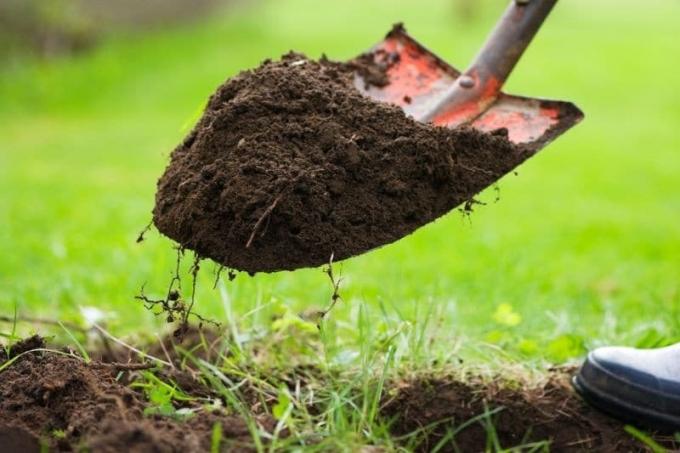
Lawn grasses should grow densely and at the same time withstand constant stress without damage. For this they need an optimal substrate. While potting soil is not mixed together for their needs, it is perfectly acceptable as a gap filler and to fill in the lawn.
In a nutshell
- Potting soil is rich in nutrients, but has a very loose structure
- Grass benefits from nutrients but lacks a firm footing (is not durable)
- Soil can only be used to fill in uneven areas and to sow gaps
- alternatively as a thin, fertilizing layer Lawn
- depending on the case improved with compost, sand and/or topsoil
Table of Contents
- Do not use for new seeding
- Reap the benefits of potting soil
- Use potting soil for repairs
- How to use potting soil
- Fill in large cavities
- Sprinkle potting soil on the lawn
- frequently asked Questions
Do not use for new seeding
Lawn grass roots must have a very firm footing in the soil. Because lawns are not just admired like flower beds, but mostly regularly walked on or even played on. This is where the weak point lies
potting soil, because it contains fibrous components or other additions that loosen it up. This is ideal for flowers, but not for lawn grasses. Grasses rooted in potting soil can be easily torn out. Even slight wear and tear on the lawn would leave visible traces, which would become larger and larger over time.
Reap the benefits of potting soil
Special lawn soil should also be used in other cases, such as closing gaps or filling in bumps. But the use of potting soil is not entirely out of the question, as it can definitely contribute a few advantages:
- is available everywhere, even in supermarkets
- much cheaper compared to lawn soil
- Use of leftovers after the last flower planting
- contains usable NPK fertilizer
- Lawn seeds grow well
- old turf gets a new growth spurt
Use potting soil for repairs
Old lawns sometimes get gaps. These must be sown again so that the lawn becomes consistently green again. Potting soil can be used for this. Since the different potting soils all have a slightly different composition, take a look at the packaging. In this way you can determine how close it comes to the ideal lawn soil. This consists of:
- 50% compost
- 35% humus
- 15% sand
- fertilizer
If necessary, you can improve the potting soil before use. For example by adding sand or compost.
Tip: Also pay attention to the ideal pH value. Lawn grasses grow best in soil that is between 5.5 and 6.5.
How to use potting soil
You can fill up small, flat bumps with potting soil at any time. If gaps in the lawn are to be greened again, wait until April or April. September. Then do the following:

- Mow the lawn as short as possible.
- Loosen up the bald spots deeply.
- Remove moss and dead lawn grass.
- Pull out any weeds and roots that may be present.
- mix lawn seed and potting soil.
- Spread the mixture evenly over the bald areas.
- Kick the earth hard.
- Water the area with a fine water jet, preferably with a spray head.
Tip: You can also apply the potting soil first and then sow the seeds on it. Then you should definitely press the seeds deeper into the ground with a board or roller so that they get ground contact.
Fill in large cavities
Pure potting soil is not suitable for filling up large depressions in the lawn. It consists largely of organic material, which is broken down over time by soil organisms. As a result, the earth will subside and the hollows will reappear, although not as pronounced.
- Mix potting soil 1:1 with topsoil
- Moisten mixture after spreading (promotes compaction)
- fill large cavities in several passes
- only sow after the earth has settled

Sprinkle potting soil on the lawn
If you have leftover soil, you don't have to wait for gaps in the lawn. You can immediately sprinkle the potting soil evenly and thinly on the lawn and thus fill in the lawn slightly. Since the lawn grasses already have a firm footing, their loose structure cannot harm them, especially since the soil is used in manageable quantities. Thanks to the nutrients nitrogen, phosphorus and potassium, potting soil acts as a small fertiliser.
frequently asked Questions
Yes, seed gaps as soon as possible. Otherwise there is a risk that bare spots will be colonized by weeds.
If the lawn is on very sandy soil, it can suffer from a lack of water because sand cannot store water. Potting soil, on the other hand, is good at storing water. When applied to the lawn, the two layers will eventually mix. This improves the water storage capacity of the subsoil.
Yes, that is possible, possibly mixed with mother earth. But before you fill up these holes and sow them again, you should first go on a "search for the culprit" and then take appropriate measures. Otherwise you will soon have new holes in the lawn.


